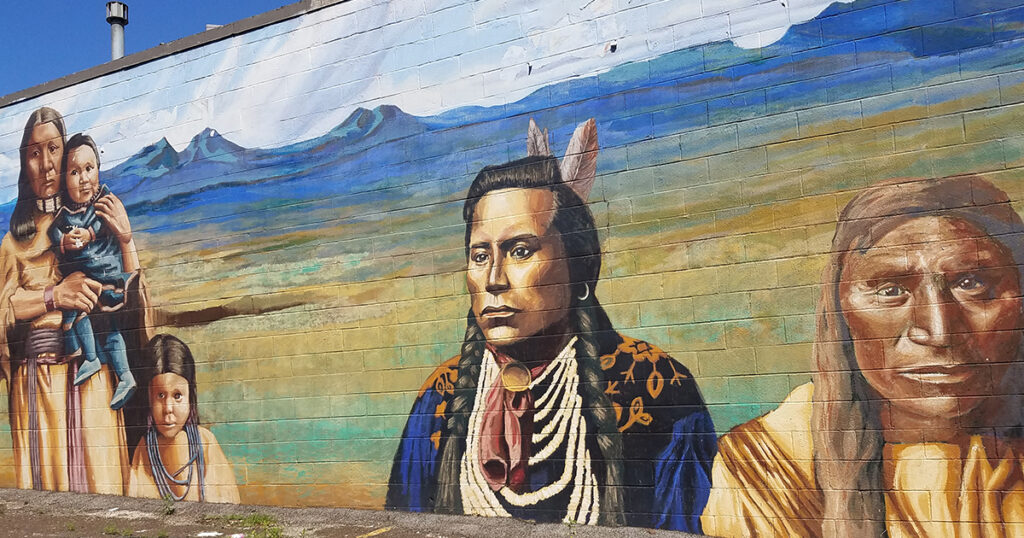
Native Nations: A Millennium in North America by Kathleen DuVal; Random House, 752 pp., $38
Football games at Louisiana State University draw tens of thousands of fans to Tiger Stadium and its environs. A sea of revelers, clad in purple and gold, spills out in all directions, and a first-time visitor—washed along to the tailgating lots northeast of the gridiron—might be surprised to come across a pair of grassy knolls lying between the Huey P. Long Fieldhouse and the student union. Known as the LSU Campus Mounds, these 20-foot hillocks, according to the university, “are among the oldest human-made edifices in the Americas,” and research shows that they were carefully aligned with one of the brightest stars in the night sky. In 1999 they were added to the National Register of Historic Places, and in recent years the university has begun fencing them off on game days to prevent damage.
The existence of these and other such structures found elsewhere in the United States underscores one of the central themes of Native Nations, Kathleen DuVal’s sweeping and important new book: sophisticated Indigenous societies flourished throughout North America long before Europeans showed up. This is now a familiar story, but it was not always so. For much of the 20th century, scholars tended to ignore Indigenous peoples altogether; many contemporary narratives that incorporate Native Americans focus mainly on their violent dispossession, ignoring their agency and persistence. DuVal, a professor of history at the University of North Carolina–Chapel Hill, offers a far more nuanced and satisfying overview of America’s Native past, focusing on seven peoples scattered across the continent, from the forests of what is now Upstate New York to the desert borderlands of the Southwest.
Of the book’s many attributes, three in particular stand out, beginning with its ambitious scope. Even those studies that do foreground the Indigenous experience often concentrate on the post-Columbian era, in part because of the scarcity of primary sources from earlier periods. But as her subtitle indicates, DuVal is committed to charting Native history across “a millennium in North America.” To that end, she has read widely in multiple scholarly fields and gleaned insights from other disciplines, as when she ponders the material culture found at the sites of ancient urban centers such as Cahokia, in Illinois, which had a population of as many as 20,000 inhabitants at its peak around 1100. Moreover, as DuVal explains, another goal of the book “is to reinsert Native American history into world history,” adding that “Native Americans became part of the global economy in the early modern era at the same time that Europeans, Asians, and Africans did,” a period marked by extensive trade networks and intercultural exchange.
DuVal also emphasizes Native viewpoints. She explores how the Kiowas, because of decisions they made, emerged as a power on the southern Plains in the mid-18th century. First, they embraced a Spanish import—the horse—which, as observed elsewhere by the Kiowa writer N. Scott Momaday, allowed them to “prevail against [their] oldest enemy—distance.” And second, they opted to become full-time nomadic bison hunters, prospering for several generations until the buffalo herds collapsed and the Kiowa were driven onto the reservation. Despite this tragic outcome, DuVal writes, “Plains people who looked back on this era from the twentieth century believed their ancestors had made the right choice.” Throughout her book, DuVal privileges the work of Native scholars, and during her research consulted with Native groups, striving, as she puts it, to live up to the call of a Shawnee official “to work with not on indigenous communities.”
Perhaps the book’s most significant contribution is its sustained case for thinking of Indigenous societies as nations. This is not a minor semantic issue. Tribe is vague and amorphous, and in the words of one Quapaw leader, it implies an “unsophisticated and unrefined condition.” By contrast, as DuVal explains, Europeans thought of Native groups as nations, which to the newcomers meant “both a polity and a people who shared attributes that united them,” from language to religion to economics. Above all, this designation recognizes Indigenous sovereignty—both then and now—as rooted in claims to the land. This is an idea that lies at the heart of much contemporary Native activism, including resistance to the Dakota Access Pipeline. DuVal begins her book with that protest, noting that at one 2016 demonstration, supporters from across the country flew the flags of Native nations.
As with any book—even one as good as DuVal’s—there are things with which a reader might quibble. Most obvious, in the case of Native Nations, is its daunting length. The sheer size of the book may chase off just the sort of nonspecialist audience that the volume seems designed to reach, given its narrative form and elegant prose style. Furthermore, DuVal spotlights seven nations when a smaller sample might have delivered much the same payoff, even after accounting for the divergent experiences of these groups. This question of coverage cuts in the other direction, too, suggested by the map included in the book’s front matter, which shows a big gap stretching from Oklahoma to the Pacific Northwest. Considering that California was easily the most densely settled part of Native North America, its exclusion is surprising.
With that said, given the well-documented renaissance across Native America in recent decades and the calls for justice since the renewed racial awakening of 2020, a deeper understanding of the country’s Indigenous history seems particularly urgent. And it is hard to imagine a more learned and humane guide to the last thousand years of this story than DuVal.

